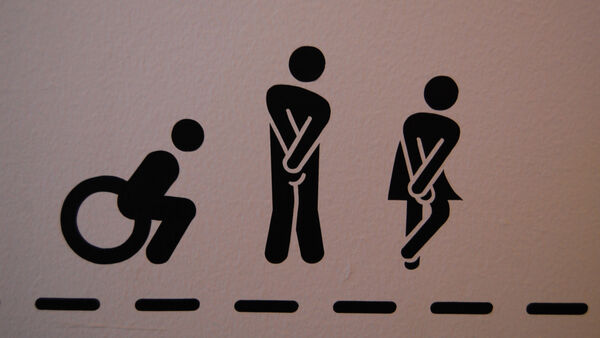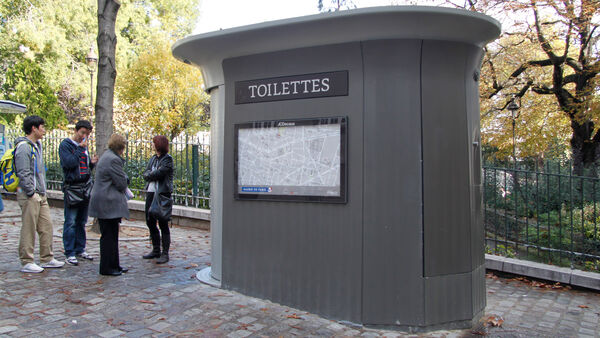European Toilet Tricks to Know Before You Go


By Rick Steves
Getting comfortable in European bathrooms takes a little adjusting, but that's travel — every world traveler has one or two great toilet stories that give "going local" a very real meaning. When in Rome, do as the Romans do — and before you know it, you'll be Euro-peein'.
Flummoxing Flushers
In Europe, you may or may not encounter a familiar flushing mechanism. In older bathrooms, toilets may come with a pull string instead of a handle (generally with the tank affixed to the wall rather than the toilet itself). In modern bathrooms, you may see two buttons on top of the tank — one performs a regular flush, the other (for lighter jobs) conserves water. In Great Britain, you'll likely come across the "pump toilet," with a flushing handle that doesn't kick in unless you push it just right: too hard or too soft, and it won't go. (Be decisive but not ruthless.)
Toilet Paper
Like a spoon or a fork, this is another Western "essential" that many people on our planet do not use. What they use varies. I won't get too graphic, but remember that a billion civilized people on this planet never eat with their left hand. While Europeans do use toilet paper, WCs may not always be well stocked. If you're averse to the occasional drip-dry, carry pocket-size tissue packs (easy to buy in Europe) for WCs sans TP. Some countries, such as Greece and Turkey, have very frail plumbing. If you see a wastebasket near the toilet with used toilet paper in it, that's a sign that the sewer system isn't up to snuff. Put your used TP in the wastebasket instead of flushing it. (The rule of thumb in those places: Don't put anything in the toilet unless you've eaten it first.)
Pay Toilets
Paying to use a public WC is a European custom that irks some Americans. But isn't it really worth a few coins, considering the cost of water, maintenance, and cleanliness? And you're probably in no state to argue, anyway. Pay toilets are the norm at highway rest areas, train stations, and even at some sights — hang on to your small change for WC stops. (Many coin-op WCs have self-cleaning toilet seats; stick around after you're done to watch the show.)
Sometimes the toilet itself is free, but an attendant in the corner sells sheets of toilet paper. Most common is the tip dish by the entry. Caution: Many attendants leave only bills and too-big coins in the tray to bewilder the full-bladdered tourist. The local equivalent of about 50 cents is plenty. The keepers of Europe's public toilets have earned a reputation for crabbiness. You'd be crabby, too, if you lived under the street in a room full of public toilets. Humor them, understand them, and carry some change so you can leave them a coin or two.
Women in the Men's Room (and Vice Versa)
The female attendants who seem to inhabit Europe's WCs are a popular topic of conversation among male tourists. Sooner or later you'll be minding your own business at the urinal, and the lady will bring you your change or sweep under your feet. Yes, it is distracting, but you'll just have to get used to it — she has. (Women may also see male employees attending to restroom maintenance.)
Gender-Neutral Bathrooms
Some European bathrooms have shared hand-washing facilities for women and men, with adjacent but separate toilet areas. And some restrooms make no distinctions for gender at all.
Squat Toilets
The vast majority of European toilets are similar to our own. But in a few out-of-the-way places, you might find a toilet that consists simply of porcelain footprints and a squat-and-aim hole. If faced with a squat toilet, remember: Those of us who need a throne to sit on are in the minority. Throughout the world, most humans sit on their haunches and nothing more. Sometimes called "Turkish toilets," these are more commonly found in, well, Turkey.
Finding a Public Restroom
I once dropped a tour group off in a town for a potty stop, and when I arrived to pick them up 20 minutes later, none had found relief. Locating a decent public toilet can be frustrating. But with a few tips, you can sniff out a biffy in a jiffy.
Restaurants
You can walk into nearly any restaurant or café, politely and confidently, and find a bathroom. Assume it's somewhere in the back, either upstairs or downstairs. It's easiest in large places that have outdoor seating — waiters will think you're a customer just making a quick trip inside. Some call it rude; I call it survival. If you feel like it, ask permission. Just smile and say, "Toilet?" I'm rarely turned down. Fast-food places usually have a decent and fairly accessible "public" restroom. Timid people buy a drink they don't want in order to use the bathroom, but that's generally unnecessary (although sometimes the secret bathroom door code is printed only on your receipt).
Even at American chains, be prepared for bathroom culture shock. At a big Starbucks in Bern, Switzerland, I opened the door to find an extremely blue space. It took me a minute to realize that the blue lights made it impossible for junkies to find their veins.
Public Buildings
When nature beckons and there's no restaurant or bar handy, look in train stations, government buildings, libraries, large bookstores, and upper floors of department stores. Parks often have restrooms, sometimes of the gag-a-maggot variety. Never leave a museum without taking advantage of its restrooms — they're clean and usually free. Sometimes you can access a museum's restrooms from the entry hall, without paying to go inside. Large, classy, old hotel lobbies are as impressive as many palaces you'll pay to see. You can always find a royal retreat here, and plenty of soft TP.
Street Toilets
Some large cities make it easy ro answer nature's call while out and about. Paris' 400 free self-cleaning public toilets (sanisettes) open with the push of a button. In some other cities, you'll see similar coin-operated, phone booth-like WCs on street corners. London has coin-op street loos; WCs in a few key transit stations (including Cannon Street, Charing Cross, London Bridge, and Victoria) are free. Some cities publish online maps of their public toilets.
You may also see free, low-tech public urinals (called pissoirs) that offer just enough privacy for men to find relief…sometimes with a view. Paris unveiled open-air urinals in high-profile locations in 2018, sparking some controversy — and protests from women who complained that public urinals were sexist. They're gone now. Munich had outdoor urinals until the 1972 Olympics and then decided to beautify the city by doing away with them. What about the people's needs? There's a law in Munich: Any place serving beer must admit the public (whether they're customers or not) to use the toilets.

